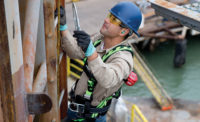Remember, 30 million Americans are exposed to hazardous noise at work, according to NIOSH. This has caused permanent hearing loss for about ten million workers. It’s a very preventable loss. Read on…
The National Park Service used two-day workshops to implement its hearing protection program. Who was targeted for attendance? Park management, full-time and collateral duty safety officers, department heads, first line supervisors, and “motivated and involved employees.â€
The park service did a concise, organized job of marketing its hearing loss prevention program. In advance, attendees were told they had an “opportunity†to learn what it takes to implement a successful program and gain practical hands-on experience.
What did the workshops cover? Day one began with a step-by-step review of hearing loss prevention program elements, and how to put them in place. Trainees learned to use sound level meters to identify noise hazards and evaluate employee exposures. Skills were reinforced by conducting a comprehensive sound level survey of the work environment. Survey data was stored for retrieval and analysis to determine employee risk. Those successfully completing the workshop received certificates of training as workplace noise monitors.
Day two focused on employees who were identified the previous day as having high-risk jobs. These workers received required employee training and on-site audiometric testing.
When rolling out any safety program, including one on hearing conservation, it’s important to motivate employees by specifying outcomes. The National Park Service listed seven:
1) Trained management, safety professionals, and supervisors with practical experience in program implementation;
2) Workshop participants receive a resource package containing the tools necessary to implement a program;
3) Completed comprehensive sound level survey;
4) Trained workplace monitors;
5) A list of exposed employees who must participate in a hearing loss prevention program;
6) Trained employees and employee involvement; and
7) Audiometric testing.
Reminders
Remember, a short, intense sound — an explosion, for example — might cause immediate hearing loss. But usually hearing loss occurs gradually after prolonged exposure to loud noise. Employees might not even realize they are losing their hearing. In time, sounds can become muffled or distorted.SIDEBAR: OSHA standard highlights
